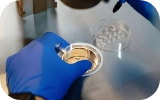Class 10000 IVF Laboratory: Ensuring Quality and Success

Under normal circumstances, the sperm fertilizes the egg in the woman’s reproductive system. In the case of IVF, this process happens in an incubator that mimics the environmental conditions of the woman’s womb. Exposure to dust, pollutants, smoke, ash, Bacteria etc. in the air can interfere with the IVF process and reduce the chances of success. Hence, it is essential for IVF labs to stay as sterile as possible.
Sterile vs Non-sterile areas
Every patient who walks into an IVF clinic interferes with the air quality. This could be through the smell of a deodorant or a perfume, particulate matter in lipsticks etc. These molecules can stay air-borne for considerable lengths of time even after the patient has left. Thus, the first step for an IVF clinic is to separate sterile and non-sterile areas. Areas, where the patient interacts with doctors and staff, are non-sterile areas. These must be isolated from the lab areas where the embryos are developed so these pollutants are kept away.
Class 10000 IVF Laboratory
The human embryo is very sensitive to the presence of chemically active compounds, volatile organic compounds, smells etc. Hence, IVF labs are recommended to have 10,000ppm in the air. This is referred to as a class 10,000 lab. To achieve this, labs must have a modular clean room that uses a combination of an HVAC air-conditioning system and PUF panels. The HVAC system controls temperature and filters harmful compounds thus controlling the level of particulate matter in the air. In addition, KP4 or potassium permanganate filters may also be used.
From the time the eggs are harvested till the time the embryo is transferred to a catheter to be inserted in the woman’s uterus, all procedures must take place in this clean room. Thus, this clean room is the most important part of the IVF clinic.
 Infertility Counselling
Infertility Counselling Female Infertility Treatment
Female Infertility Treatment Andrology Treatment
Andrology Treatment Fertility Enhancing Surgeries - Female
Fertility Enhancing Surgeries - Female Fertility Enhancing Surgeries - Male
Fertility Enhancing Surgeries - Male Endoscopy Treatment
Endoscopy Treatment IUI Treatment
IUI Treatment IVF Treatment
IVF Treatment ICSI Treatment
ICSI Treatment Advanced IVF Solutions
Advanced IVF Solutions Embryology
Embryology Vitrification Egg, Embryo, Sperm Freezing
Vitrification Egg, Embryo, Sperm Freezing Preimplantation Genetic Testing (PGT)
Preimplantation Genetic Testing (PGT) Donation Program Embryo / Egg / Sperm
Donation Program Embryo / Egg / Sperm Self-cycleTM IVF
Self-cycleTM IVF

 Self-cycleTM IVF
Self-cycleTM IVF










